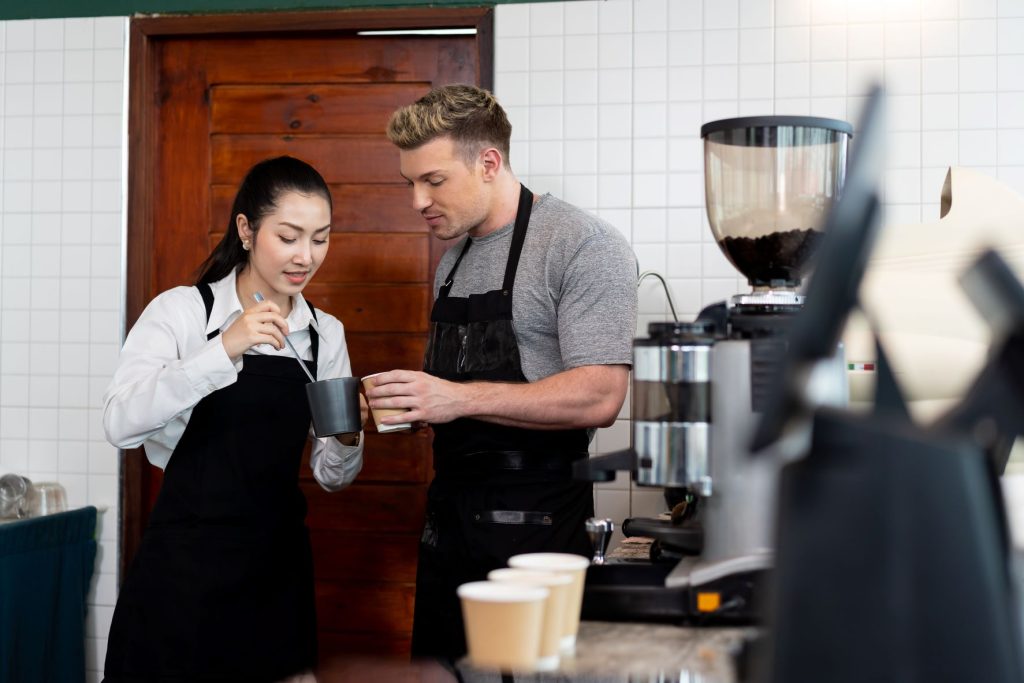The success of a restaurant depends on many factors, including training, instruction, reinforcement of quality standards, and spending quality time supervising your staff. Your staff is the public representative of your company; how they interact with clients may determine whether your restaurant succeeds or fails. Restaurant employee training must be conducted well to be effective, and one of the ways to achieve that is by employing restaurant training videos. Restaurant training videos should be hosted and served via a training tool that allows the following:
- New restaurant staff can watch from anywhere
- Trainers can monitor views easily
- Assessments can be measured to know if more training will be needed.

How do you Train Restaurant Staff?
Investing in restaurant staff training videos is a sound business decision as the well-trained staff makes a significant uplift for the restaurant and contributes to the company’s image. We have put together a list of tried-and-true techniques to help you efficiently train your restaurant staff.
1. Orientation
Orientation is the first stage of employee training. Employee orientation aids in acquainting new hires with the facility, operating procedures, goals, history, and philosophy of the business. Regardless of their experience, the business must provide the best restaurant orientation training available for every new employee to start off on the right foot.
2. Create and Upgrade your Training Plan
Training your employees is one of the ways to guarantee restaurant growth. Your training program should cover all of the divisions inside your restaurant, including, but not limited to, the bar, dining, cooking, hosting, and food safety training videos. Keep in mind to update your training videos and restaurant training manual as necessary.
3. Guidance and Observation
It is crucial to understand that training your employees doesn’t stop after giving them orientation and initial training. Restaurant managers should ensure that department heads continue directing and supervising the activities of their staff. Observation and guidance ensure that staff put what they have learned into practice. That entails offering the consumers services in accordance with the recommended procedures as trained.
4. External Training
Keeping up with the latest trends is essential since the world is constantly evolving, and employee training technology is not an exception. The easiest way to keep up with the trends is todo this through external training. Your restaurant may hire or collaborate with an outside training organization to train your workers, in parallel with your in-house trainers
Why is Training Important in Restaurants?
Building a restaurant training video plan seems like a waste of time and resources to many restaurant owners, but little did you know that it can help improve your restaurant’s operations and increase your overall profit. Let’s look at the reasons why a well-structured restaurant staff training plan is important.
1. Staff Retention
Training your employees makes them feel valued and confident at their job. Employees seek to work in an environment where they may grow professionally every day. Since training offers opportunities for growth, advancement, and learning, it increases employee commitment to a company.
2. Deliver Better Customer Service
To keep your customers, your restaurant staff must undergo adequate training to provide consistent and comprehensible customer service. They must know how to greet clients, speak to them, offer them the right dishes from the menu, and present items in accordance with consumer preferences without invading their privacy.
3. Maintenance of Health and Safety Standards
Training your employees on food health and other safety standards helps to maintain the safety regulations, produce high-quality products, keep employees and customers safe, and preserve your Food service license. Employee training using the food service training videos can help with visual step-by-step instructions of proper food handling and cleanup procedures to follow health regulations, keeping the food prep space spotless, and producing dishes of outstanding quality.
4. Improves Overall Operations
Restaurant training videos help to prevent confusion and the possibility of errors. You are investing in the general well-being and longevity of your food service business by giving your staff the necessary training. This is to ensure that clients receive the best eating experience possible at your restaurant.
Restaurant Training Videos Examples
Did you know that your staff is 75% more likely to watch videos than read a manual? Here are examples of best practices of restaurant training videos you can show to your staff, or just be inspired by and create your own using the Bites app:
- Prepping a Pineapple for Juicing: More than cutting and slicing the pineapple, there are more steps to follow. Click on the link to watch how to prepare a pineapple for juicing.
- Learn the Most Popular Cocktail: From the perfect mojito, classic margarita, easy gin tonic, or refreshing Aperol, there are available ready-made videos you can watch to learn the classic way of preparing these cocktails, or training the bartenders at your food service business.
- How to Carry 8 Glass Wines Efficiently: Looks unreal? Nothing beats practice. You can learn a new skill by watching this video to learn how to carry 8 glass wines properly without clumsiness.


How to Convert Traditional Restaurant Training Manuals into Video Content
Making restaurant training videos can be overwhelming; you can follow the steps below to convert your traditional training manuals into video content.
- Step 1:Set goals and objectives – understand your training goals and define your learning objective.
- Step 2:Create a learner profile for your audience, i.e., who is this training video for?
- Step 3:Review your current restaurant training manual and see ; pick a topic per video.
- Step 4:Select your video format and type based on your resources, timeline, and goals.
- Step 5:Create your training video script – you can get script ideas from your traditional restaurant training manuals. Make sure it is conversational, well organized, and easy to understand.
- Step 6:Record your training video – you can use a smartphone or a camera.
- Step 7:Edit your training videos – You don’t have to use video editing tools for training content creation. There are many great editing apps available online for free – Starting from Tiktok for basic video editing to Bites where you can edit videos, add graphics, voiceover, auto-generated subtitles and much more.
- Step 8:Review the restaurant training videos and gather feedback from other team members and L&D professionals.
- Step 9:Share and distribute the training videos to your restaurant staff.
Do’s and Don’ts in Creating Training Videos for Restaurant Staff Training
There are guidelines to follow when crafting your restaurant training videos, and there are things to avoid producing quality and effective training videos.
Do’s in Crafting Restaurant Training Videos
- Include a Presenter: Engaging your audience and adding a sense of consistency to your series can be made easier by using a recognizable presenter to guide viewers through the phases.
- Make it interactive: Quizzes and chats add audience engagement to your video and provide feedback on how well the training was absorbed.
- Keep your videos short: Keeping your videos brief helps to enhance viewer engagement. Therefore, if you want to cover multiple topics, it can be better to make several short movies and group them into a playlist than a long-form one.
- Ask questions: Questions can help your staff retain the information as they have to think and engage with the material rather than just viewing it.
- Consider your video’s pacing: When it comes to training videos, the pacing is crucial. In some cases, slow videos are the way to go because viewers need time to process what they are seeing and hearing; in other cases, especially when dealing with younger employees such as gen-z and millennials, fast and fun would work better.
- Entertain while you educate: Ensure to put a smile on the face of the employees who watch it.
Don’ts in Creating Restaurant Training Videos
- Don’t try to cover too many topics in one video. It will be too long and confusing.
- Don’t be too static – you should avoid showing just a single person sitting in front of a camera talking as it can result in low engagement rates
- Don’t be too restless – to maintain audience interest and focus, combine motion with simple still images.
- Show, don’t tell – It produces more captivating videos if you can show a demonstration of the actions in addition to voiceover.
- Don’t shoot from afar – fill the frame and observe every square inch of the space.
- Don’t shoot in a noisy environment – You can use the Bites noise cancelation feature to remove any background noise.
- Don’t wear distracting clothes – avoid loud print and bright colors.
Conclusion
Training new and existing restaurant staff is time and resources consuming; hence, you must ensure that the training program and video suit your staff’s learning process.If you are unsure of what training program works best for your staff, you should contact Bites to help you choose the best training strategy to increase efficiency and, in turn, improve overall profit.




















